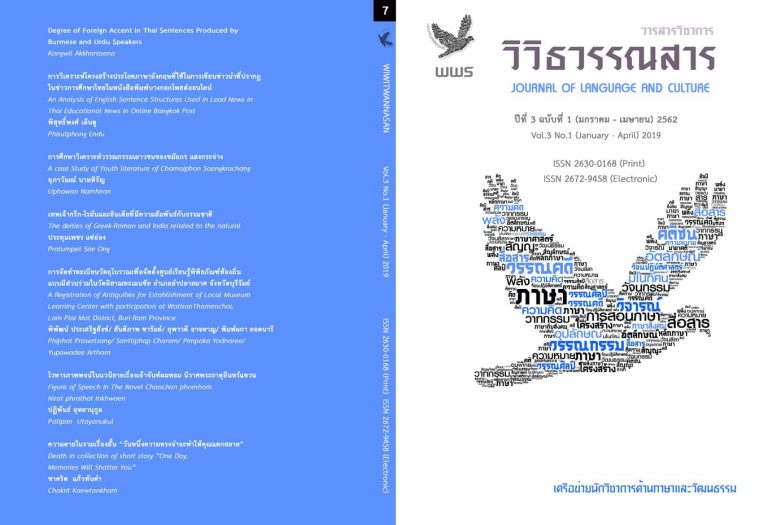A Registration of Antiquities for Establishment of Local Museum Learning Center with participation at WatIsanThamenchai, Lam Plai Mat District, Buri Ram Province
Main Article Content
Abstract
The study entitled ‘A registration of antiquities to establish a Local Museum Learning Center with participation at WatIsanThamenchai, Lam Plai Mat District, Buri Ram Province’aimed at preparing the register of antiques and establishment of Local Museum Learning Center with Participation at WatIsanThamenchai, Lam Plai Mat, Buri Ram Province. The research found that there were many types of antique without classification or registration. The registration of antiques was divided into two types: 1) Ancient objects with total number of registered objects of 163, with the following 9 types: 69 wood carving Buddha images, 4 horny carving Buddha images, 23 bronzedBuddha images, 1 stone carving Buddha Image, 1 resin molding Buddha image, 1 stucco molding Buddha image, 55 brass tray molding Buddha images. 4 palm leafmanuscriptbookcases, 5 clay pots; 2) Registration of palm leaf manuscript was considered as another type of antiquities that have the minutiae of registration, quite different from other types of antiquities, which needed to separate out the system and make a separate registration. The layout of the system consisted of a total of 144 batches with two types of ancient scripts: Tham-Isan Script and Thai-Khom Script which were classified into 9 categories as follows: Buddha’s birth story, Abhidhamma, Local fable,- fruit of merit, virtuousfable, Pali scripture, chanting, SuttantaPitaka, and legend of Buddhism. In the establishment of a Local Museum Learning Center in WatIsanThamenchai, using a multi-purpose building. In exhibition of antique, objects had been categorized before the exhibition and arranged in the classification. The space in the first floor exhibition hall was wide and suitable for exhibitions of palm leaf manuscript, because the palm leaf manuscript that was classified was quite plenty, as it included elements related to thethat was classified was quite plenty, as it included elements related to the palm leaf manuscript to be exhibited together, for instance, a bookcase for the palm leaf manuscript, wrap for palm leaf manuscript, and antique box for palm leaf manuscript. The second floor consisted of a large hall and two small rooms. The research team used a small room as an exhibition room for ancient wooden Buddha image, because of the number of wooden Buddha image to be displayed took up less space; moreover, there were also 4 cabinets forwooden Buddha images.
Article Details
Copyright is that of the journal any reproduction must be permitted by the editor of journal
References
nai phaktawan-ok chiangnuea. (in Thai) [An exhibition of model of
local museum in the northeastern region] (Master’s Thesis), Graduate
School, Chulalongkorn University, Bangkok.
Phionim, M. (1981). rai-ngan kanwichai rueang laksana khrongsang thang
sangkhom khong chumchon lae khwam samphan korani sueksa
bantalingchan, ban danlanhoi lae banmueangkao Amphoe
Mueang Changwat Sukhothai. (in Thai) [Report on characteristics
of social structure of community and relation of wat and community:
a case study of Ban Talingchan, Ban Danlanhoi and Ban Mueang Kao,
Mueang district, Sokhothai province]. Nakhonprathom: Silpakorn
University.
Suepwatthana, T. et.al.(2005). Kansueksa prawattisat lae watthanatham
phuea kan chattang phiphitthaphan thongthin (in Thai) [ A study
of history and culture to establish Local Museum]. Mahasarakham:
Mahasarakham University.
Nuamduang, T. (1995). Kan namsanoe rupbaep kan chat tang phiphitthaphan
phuenban Changwat Ang Thong. (in Thai) [An exhibition of model
of local museum establishment in Ang Thong province] (Master’s
Thesis), Graduate School, Kasetsart University, Bangkok.
Suwan, M. et. al. (2003). Khrongkan wichai rueang kan truatsop khong
ongkon phakprachachon nai rabop kanchatkan (in Thai) [Auditing
of public organization in the system of management and public affairs
of local administration]. Chiang Mai: Chiang Mai University.
International Council of Museums. (1993). International Council of Museums,
ICOM. 3-4.

